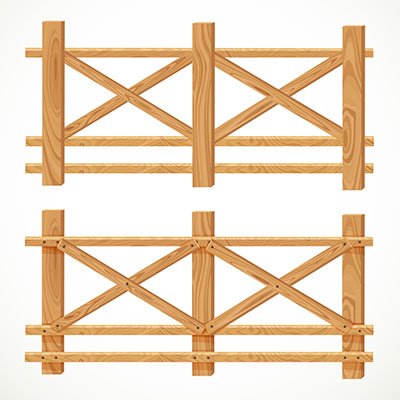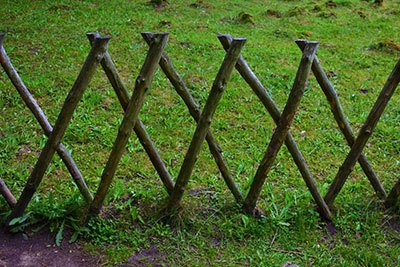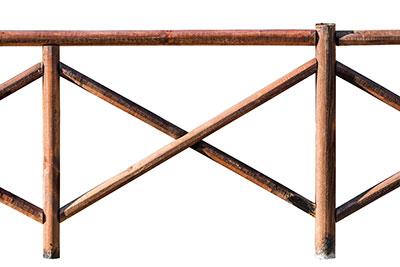Are you looking for a fencing solution that not only looks great but is more efficient than the normal fencing around your property? Cross-fencing might be exactly what you’re looking for!
Not sure what cross fencing is, or why it’s so popular? Don’t worry; we’ve got your back!
We’ll explain all about cross fences, from what they are and how they work to their many practical uses and advantages. Read on to learn more!
Take away key points:
- The cross fence is perfect fencing for soggy areas and noxious plants
- It’s installed inside a perimeter fence and similar options to physically hold animals divided into more parts. It works well with larger and smaller animals
- But, if you need to psychologically control animals, electric fences are a better choice, although you can separate animals
Table of Contents
If you need to learn more about cross fences, their purpose, benefits, and how to use them properly, refer to our guide below. We will explain everything in detail.
What is cross fencing?

Cross fencing refers to the installation of fences inside a perimeter fence to divide a grazing area into two or more separate paddocks. This management tool is commonly used in rotational grazing systems to:
– improve forage quality,
– extend the grazing season,
– decrease or even eliminate the need for supplemental feed costs.
A cross fence provides flexibility in pasture management, allowing farmers and ranchers to control uneven grazing intensity and pattern, increasing the carrying capacity of their land.
What is the main role of the cross fence?
Cross fencing is a significant agricultural practice that involves dividing a large pasture into smaller sections. This technique is highly beneficial for livestock farmers separating animals, rotating pasture, and keeping livestock out of soggy areas.
In summary, the purpose of cross-fencing is to optimize pasture utilization, improve grazing management, and enhance animal health and productivity in livestock farming.
When should you use the fences?
When should you use cross barriers? Whenever you want to achieve more efficient use of your pasture or flexibility in managing your uneven grazing rotation.
The fencing can help you achieve better forage utilization by allowing you to segment your land into smaller grazing areas, to prevent overgrazing in some areas while giving others a chance to rest and recover.
One of the best times to use fight barriers is during spring when grass growth is most abundant. Dividing your pasture into smaller portions allows you to match your grazing patterns with your grass growth, ensuring that your animals get the maximum benefit from your land.
You can use electric cross fences – both portable and permanent, to divide your grazing areas strategically and provide greater pasture management flexibility in managing your grazing rotation.
Crossing fence types
The fences can be both temporary and permanent.
Temporary fencing can be easily installed, moved, or taken down when necessary and is ideal for situations where a more permanent fence is not required or where flexibility is important.
Permanent posts, on the other hand, are constructed using more heavy-duty materials and are designed to last for many years. They might contain heavy steel woven wire to psychologically hold animals, but they are more expensive.
However, temporary cross systems don’t need to be as heavy-duty as permanent posts. They can be semi-permanent or even made using a combination of permanent and temporary fight barriers.
How can you use cross fences?

To make the most of cross systems, it’s recommended to use at least two and preferably three strands of electric wire on perimeter fence models and two strands on cross systems. Using a combination of permanent and portable cross fences can help maximize the grazing potential of your land.
If you’re planning to grow forage, cross-models help to allocate specific areas for different crops. This means rotating pasture and crops and improving soil quality over time. This leads to healthier plants and better yields.
What are the benefits of cross fences?
There are several benefits of using cross fences.
Firstly, fencing enables pasture management flexibility. By dividing an area with electric or permanent fences, farmers and ranchers can change the size of paddocks on the go.
Secondly, perfect fencing can increase pasture carrying capacity. By subdividing pastures, fencing can help farmers utilize formerly underutilized areas and optimize grazing patterns.
Thirdly, the fence is flexible and adaptable. Permanent posts or electric cross systems offer flexibility in dividing an area, making it easier to manage the grazing behavior of livestock. So, separating animals will help with overall breeding status and also cleaning land of noxious plants.
Disadvantages of using cross fences
While the fences have many benefits in terms of pasture management and rotational grazing, they do come with some disadvantages that you should keep in mind.
One disadvantage is that they can be expensive to install, especially if you opt for more high-tech fencings materials such as electric fences or wire-ups.
Additionally, the fences can make it more difficult to access certain areas of your pasture or farm, which may be inconvenient for maintenance, fertilization, or other activities.
Another factor to consider is that fences can sometimes create issues with cattle behavior. If the fences are not well-maintained or are not appropriate for the size or breeding status of your cattle, they may be more likely to cause stress or injury to the animals.
Despite these potential downsides, these fences remain a valuable tool for any farmer or rancher looking to improve their pasture management practices.
Cross fence vs. Other fencing types
We’ll dive into the details and explain the differences and benefits of cross fences with other fencing types. Let’s see.
1. Cross fence vs. regular fence
A cross fence can offer both flexibility and permanence. With portable options available, you can switch up the layout of your land as needed while still maintaining sturdy and long-lasting fencing.
Plus, the cross fence can be electric, which can be an effective way for keeping livestock in designated areas.
On the other hand, regular fences, such as wood rails, can also offer durability and security. However, one downside to using them as a sole perimeter fence is that they can have low visibility, making it more difficult to keep watch over your property.
Ultimately, the choice between a cross fence or a regular fence depends on your specific needs and preferences. Consider factors such as cost, ease of installation, and the type of animals you need to keep in or out of certain areas.
2. Cross fence vs. electric fence
Cross fencing with permanent fences can be expensive and time-consuming to install, whereas electric cross-fencing can be both a permanent and portable electric fence. The installation costs and ease are factors to consider.
If you already own an electric fence, you may be able to cross fence your pastures with it, keeping livestock separated, and encouraging them to graze more evenly and completely. You can also combine a permanent and electric cross fence.
Electric fencing generally costs less than a barbed wire fence since fewer materials are required, such as fewer posts, and can be used for pastures or cross-fencing. Additionally, a portable electric fence with one or two strands of wire can be a better option for more mobile applications. Just one little wire is enough to control the smaller animals, installed inside the property.
Regardless of the type of electric fence used, the voltage of the shock from the fence can be adjusted to deter both people and animals from crossing a boundary. However, training sheep and lambs to respect electric fences is necessary.
Tips for cross fence maintenance

Here are some tips to help you maintain your cross fence:
– Inspect regularly: Check your fences periodically for signs of damage or wear and tear. Look for sagging wires, broken posts, loose staples, and other issues that may compromise the fence’s integrity.
– Keep the fence clean: Accumulated debris can cause damage to your cross fence if not dealt with promptly. Clean the area around the fence regularly to prevent leaves, branches, and other debris from getting stuck between them.
– Replace damaged parts: If you notice any damage to your cross fence, don’t put off repairs. Repair or replace damaged posts, slats, or wires as soon as you can to avoid further damage.
– Use the right tools: Ensure you use proper fencing tools when working on your cross system. Remember, your fence must stay taut to keep your animals contained.
By following these simple tips, you can prolong the life of your cross fence and avoid significant repairs or replacements. Keep your livestock safe and have peace of mind knowing your fences are well-maintained.
Summary
The crosse fence is an ideal option to separate your animals, physically hold them inside their designated area and help with soggy areas of your land. But, if you want to psychologically control the animals, use electric fences.
